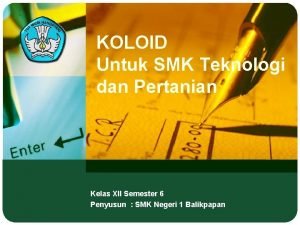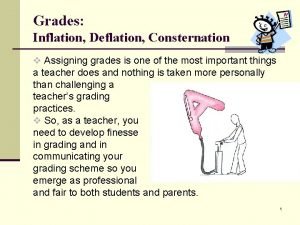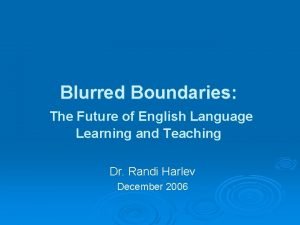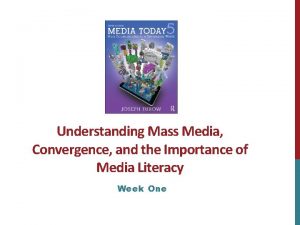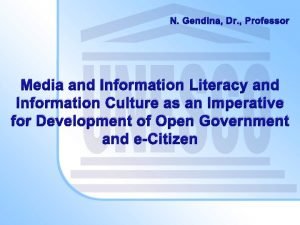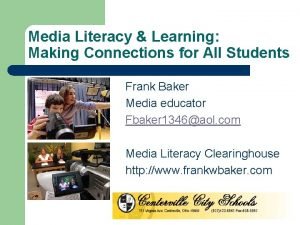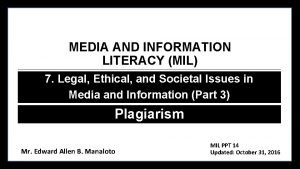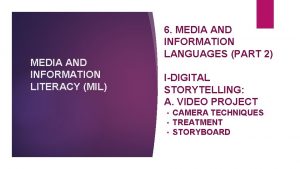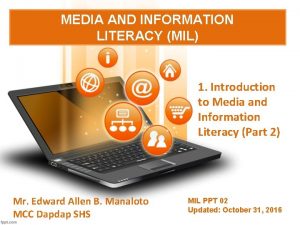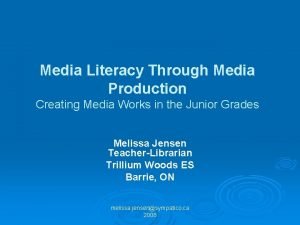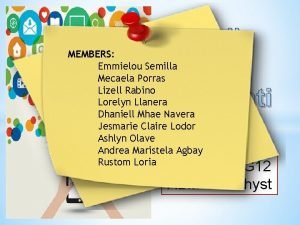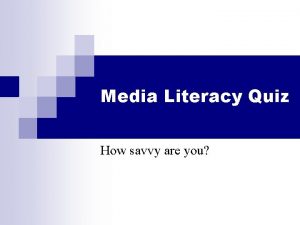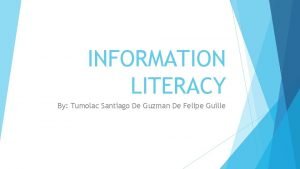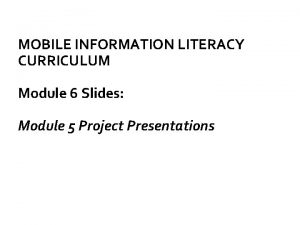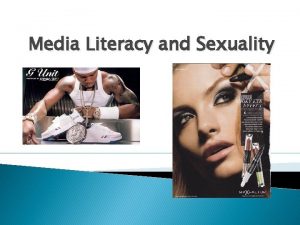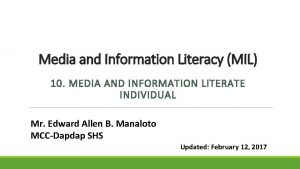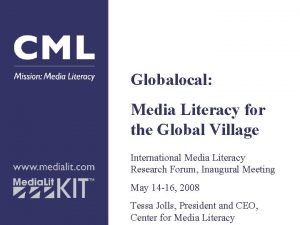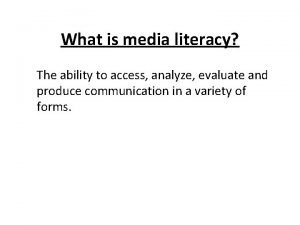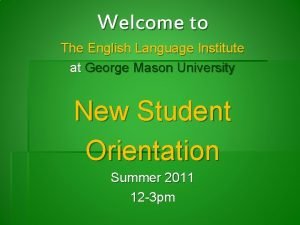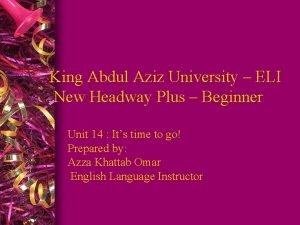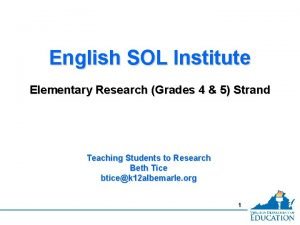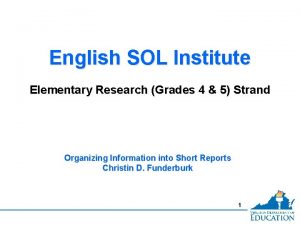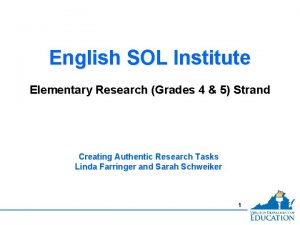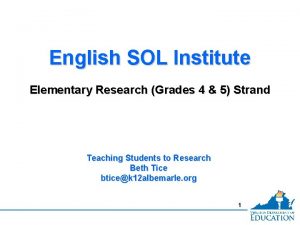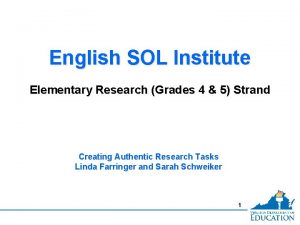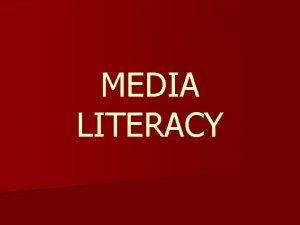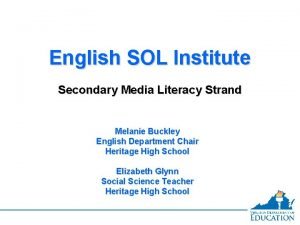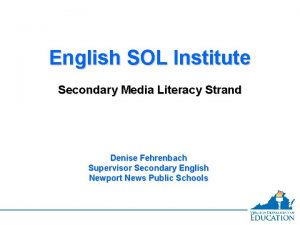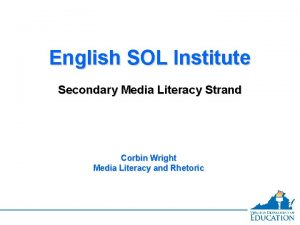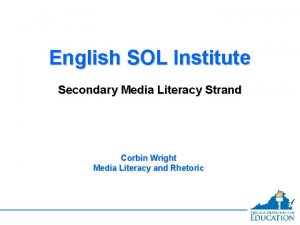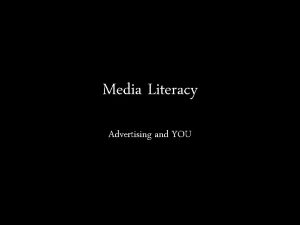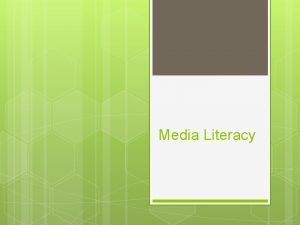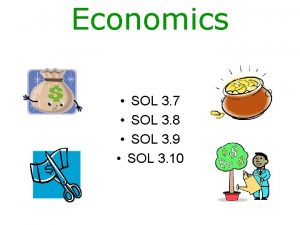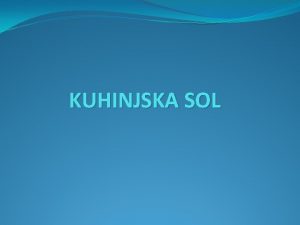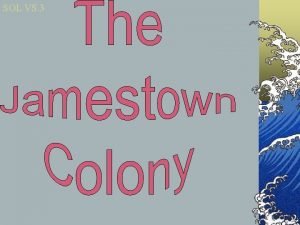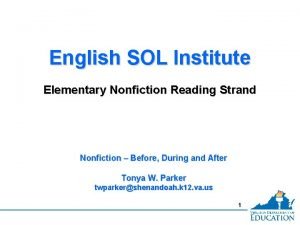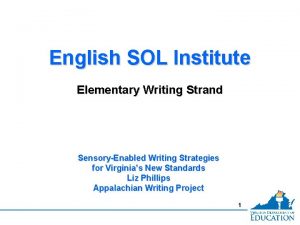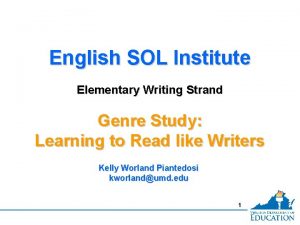English SOL Institute Elementary Media Literacy Grades 4


























- Slides: 26

English SOL Institute Elementary Media Literacy (Grades 4 & 5) Strand Shelia Sargent-Martin Bluefield State College 1

Media Literacy (Grades 4 & 5) Key Points in Media Literacy • Strand should be integrated into content area lessons • Critical thinking/viewing of media emphasized • Deconstruction emphasized beginning in grade 5 2

Media Literacy (Grades 4 & 5) Key Points in Media Literacy • Several attributes examined: authorship, format, audience, content, and purpose (audience and purpose only at grade 4) • Students not just consumers but producers of media (beginning at grade 5) 3

Core Concepts Media messages are constructed Are constructed using a creative language with its own rules Different people experience the same message differently Media have embedded values and points of view Most media messages are organized to gain profit and/or power Key Questions Who created the message? What techniques are used to attract my attention? How might others understand this message differently from me? What lifestyles, values, and points of view are represented in, or omitted from, this message? Why was this message sent? www. medialit. org

Media Addressed in Virginia’s Standards of Learning Auditory media can be heard (e. g. , music, radio, speeches, video, etc. ). Visual media can be viewed (e. g. , television, video, Web-based materials, etc. ). Written media includes text (e. g. , newspapers, magazines, books, advertising, etc. ).

Virginia Standards of Learning Standard All students should… To be successful with this standard, students are expected to… 4. 3 The student will learn how media messages are constructed and for what purposes. a) Differentiate between auditory, visual, and written media messages. b) Identify the characteristics of various media messages. Identify attributes of constructed message (i. e. , audience and purpose) Access media messages and identify what types of media are used. 5. 3 The student will learn how media messages are constructed and for what purposes. a) differentiate between auditory, visual, and written media messages. b) identify the characteristics and effectiveness of a variety of media messages Understand media messages are constructed and students have the ability to deconstruct messages by looking at several attributes: authorship, format, audience, content, and purpose. Understand how to evaluate the effectiveness of a media message by examining the various attributes of messages • access media messages and identify what types of media are used. • identify the attributes of a constructed message (i. e. , authorship, format, audience, content, and purpose). • deconstruct several types of media messages by addressing the main question(s) raised by the media attributes. • create age-appropriate media messages (e. g. , videos, podcasts, print advertisements) for evaluation, focusing on effectiveness of the message.

Understanding the Standard SOL 4. 3 • The intent of this standard is that students will learn that media messages are constructed for a purpose. Students will examine the following: • Audience (Who is the person or persons meant to see the message? ) • Purpose (Why is the message being sent – is it meant to persuade, inform, entertain, sell, or a combination of these? )

8

Audience Guiding Questions: • Have you ever experienced anything like this? • How close does it come to what you experienced in real life? • What did you learn from this media text? What did you learn about yourself from experiencing the media text? • What did you learn from other people’s response —and their experience? • How many other interpretations could there be? How could we hear about them? • How can you explain the different responses? • Are other viewpoints just as valid as mine? Adapted from www. medialit. org

Purpose Guiding Questions: • Who’s in control of the creation and transmission of this message? • Why are they sending it? How do you know? • Who are they sending it to? How do you know? • Who is served by, profits or benefits from the message? The public? Private interests? Individuals? Institutions? • Who wins? Who loses? Who decides? • What economic decisions may have influenced the construction or transmission of the message? Adapted from www. medialit. org

Understanding the Standard SOL 5. 3 • • • The intent of this standard is that students will learn all media messages are constructed and that to understand the whole meaning of the message they can deconstruct it, looking at the following attributes: Authorship (Who constructed the message? ) Format (This is not just the medium being used but also how the creators used specific elements for effect, i. e. , color, sound, emphasis on certain words, amateur video, children’s voices. ) Audience (Who is the person or persons meant to receive the message? How will different people interpret the message? ) Content (This is not just the visible content but the embedded content as well which includes underlying assumptions of values or points of view; facts and opinions may be intermixed. ) Purpose (Why is the message being sent—is it meant to persuade, inform, entertain, sell, or a combination of these? )

Understanding the Standard SOL 6. 3 • • • The intent of this standard is that students will be able to identify elements of media literacy recognizing that elements of media literacy are based on audience and purpose. They will also learn all media messages are constructed and that to understand the whole meaning of the message they can deconstruct it, looking at the following attributes: Authorship (Who constructed the message? ) Format (This is not just the medium being used but also how the creators used specific elements for effect, i. e. , color, sound, emphasis on certain words, amateur video, kids’ voices. ) Audience (Who is the person or persons meant to see the message? How will different people see the message? ) Content (This is not just the visible content but the embedded content as well which includes underlying assumptions of values or points of view; facts and opinions may be intermixed. ) Purpose (Why is the message being sent—is it meant to persuade, inform, entertain, sell, or a combination of these? )

13

Author Guiding Questions: • What kind of “text” is it? • What are the various elements (building blocks) that make up the whole? • How similar or different is it to others of the same genre? • Which technologies are used in its creation? • How would it be different in a different medium? • What choices were made that might have been made differently? • How many people did it take to create this message? What are their various jobs? www. medialit. org

Message/Content Guiding Questions: • How is the human person characterized? What kinds of behaviors /consequences are depicted? • What type of person is the reader / watcher / listener invited to identify with? • What questions come to mind as you watch / read / listen? • What ideas or values are being “sold” in this message? • What political or economic ideas are communicated in the message? • What judgments or statements are made about how we treat other people? • What is the overall worldview? • Are any ideas or perspectives left out? How would you find what’s missing? Adapted from www. medialit. org

Format Guiding Questions • What do you notice. . . (about the way the message is constructed? – Colors and shapes? – Sound effects? Music? Silence? Dialogue or Narration? – Props, sets, clothing? – Movement? Composition – Lighting? • Where is the camera? What is the viewpoint? • How is the story told? What are people doing? • Are there any visual symbols or metaphors? • What’s the emotional appeal? Persuasive devices? Adapted from www. medialit. org • What makes it seem “real”?

17


Keep America Clean www. youtube. com/watch? v=j 7 OH G 7 t. Hr. NM 19

Questions to Guide Young Children Core Concepts All media messages are constructed Key Questions Who created the message? Media messages are What techniques are constructed using used to attract my creative language with its attention? own rules. Keywords Author 4. 3, 5. 3, 6. 3 Format & techniques of production 5. 3, 6. 3 Different people experience the same media message differently How might people Audience understand this message 4. 3, 5. 3, 6. 3 differently from me? Media have embedded values and points of view What lifestyles, values Content-meaning and points of view are 4. 3, 5. 3, 6. 3 represented in or omitted from this message? Most media messages are organized to gain profit and/or power What was this message sent? Motive- purpose 5. 3, 6. 3 Adapted from www. medialit. org

Producers Podcasts Videos Print Advertisements 21

RAFT Role: Thomas Jefferson Audience: Current President or Congress Format: Letter of Advice Topic: Explain the quote “A democracy is nothing more than mob rule, where fifty-one percent of the people may take away the rights of the other forty-nine. ” Role: Casey Anthony Jury Member Audience: Public Format: Letter/book Topic: Explain how/why you came to your decision. Your turn- use one of these prompts or create your own. What would you create and how would you share?

Thank You! Shelia Sargent-Martin ssmartin@bluefieldstate. edu

Resources Center for Media Literacy www. medialit. org Alliance for a Media Literate America www. amlainfo. org Media Education Foundation www. mediaed. org Media Literacy Project www. medialiteracyproject. org PBS Teacher. Source www. pbs. org/teachersource “Flipping the Script” www. justthink. org/flippingthescript

Resources cont. The Virginia Department of Education www. doe. virginia. gov The Journal of Media Literacy Education http: //jmle. org/index. php/JMLE/index The National Archives Experience: Docs Teach www. docsteach. org Education Week Digital Directions: Trends and Advice for K-12 Technology Leaders http: //www. edweek. org/dd/ (free E-Newsletter available)

Disclaimer Reference within this presentation to any specific commercial or non-commercial product, process, or service by trade name, trademark, manufacturer or otherwise does not constitute or imply an endorsement, recommendation, or favoring by the Virginia Department of Education. 26
 Media literacy and information literacy
Media literacy and information literacy What is mil subject
What is mil subject What are the characteristics of people media?
What are the characteristics of people media? Pemisahan koloid dengan cara penyaringan
Pemisahan koloid dengan cara penyaringan Cyber literacy for the digital age
Cyber literacy for the digital age Grade deflation definition
Grade deflation definition English literacy in europe
English literacy in europe Media literacy person
Media literacy person What are the challenges brought by media and information
What are the challenges brought by media and information Ecology of media and information literacy
Ecology of media and information literacy What is media literacy
What is media literacy Potluck paper plagiarism
Potluck paper plagiarism Mil media and information languages
Mil media and information languages Cartoon analysis about media
Cartoon analysis about media Access in media literacy
Access in media literacy Poster making about media literacy
Poster making about media literacy Ohp lcd projectors electronic age
Ohp lcd projectors electronic age A b c d question media
A b c d question media Disaster scenario according to the weather forecast
Disaster scenario according to the weather forecast How do we get the meaning of code and conventions
How do we get the meaning of code and conventions Media and information literacy module 6
Media and information literacy module 6 What is media literacy
What is media literacy Graphic organizer about media and information literacy
Graphic organizer about media and information literacy What is media literacy
What is media literacy Media literacy means the ability to
Media literacy means the ability to Eli gmu
Eli gmu King abdulaziz university english language institute
King abdulaziz university english language institute



